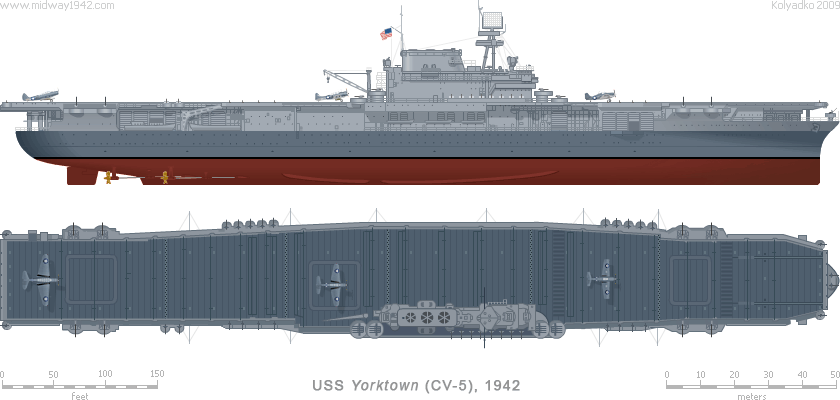
| Yorktown class | AIRCRAFT CARRIERS | |

| Displacement: | 25,500 t (19,800 t Std) | Machinery: | 9 boilers, 4 shafts | Flight Deck: | 802 ft 244.5 m | DP Guns: | 8×1×5 in (127 mm)/38 | |||||||||
|---|---|---|---|---|---|---|---|---|---|---|---|---|---|---|---|---|
| Max Length: | 809 ft 6 in | 246.7 m | Max Power: | 120,000 hp | 89 483 kW | Fighters: | 27× F4F-4 Wildcat | AA Guns: | 4×4×1.1 in (28 mm) | |||||||
| Beam: | 109 ft 6 in | 33.4 m | Max Speed: | 32.5 kts | 60.2 km/h | Bombers: | 36× SBD-3 Dauntless | AA Guns: | 24×1×.79 in (20 mm) | |||||||
| Draght: | 25 ft 11 in | 7.9 m | Range: | 12,500 nm | 23 150 km | Torpedo: | 15× TBD-1 Devastator | AA MG's | 12×1×.50 in (12.7 mm) | |||||||
* Antiarcraft armament and Air Group as during the Battle of Midway.
The lessons learned from operations with the large converted battlecruiser Lexington class in comparison with the smaller purpose-built Ranger had taught the U.S. Navy that large carriers were more flexible in operational terms and were more survivable than smaller ones. As a result of this experience, the Navy built three Yorktown class ships, fast and versatile carriers able to carry and operate over 80 warplanes which was almost as many as the much larger Lexington class.
USS Yorktown (CV-5), the lead ship of her class, was commissioned on 30 September 1937. Before the United States entered the war, Yorktown conducted “Neutrality patrols” in the Atlantic, but after the Pearl Harbor attack, she was transferred to the Pacific and took part in the Marshalls-Gilberts raids and the Battle of Coral Sea, where on 8 May 1942 she was hit by a bomb. After the hasty repair Yorktown took part in the Battle of Midway, where she became the only target for both Japanese counterattacks and was hit by three bombs at 1220, 4 June 1942, and by two aerial torpedoes at 1420. The crew was ordered to abandon Yorktown, but the ship remained afloat and two days later was hit by two torpedoes from a Japanese submarine. At 0501, 7 June 1942, the Yorktown sank at position 30°46' N, 167°24' W.
USS Enterprise (CV-6) was commissioned on 12 May 1938, and in April 1939 was ordered to duty in the Pacific. She entered the Pacific War on the very first day and participated in more major actions of the war against Japan than did any other U.S. ship. These actions included the Battle of Midway, the Battle of the Eastern Solomons, the Battle of the Santa Cruz Islands, various other air-sea engagements during the Guadalcanal Campaign, the Battle of the Philippine Sea and the Battle of Leyte Gulf, as well as dozens of the raids against various islands and naval bases, including the famous “Doolittle Raid” on Tokyo. She provided close air support to the landings on Makin Atoll, Kwajalein, Emirau, New Guinea, Saipan, Leyte, Iwo Jima, and Okinawa islands, where she was seriously damaged by a kamikaze. After the repair the Enterprise began “Operation Magic Carpet”, a series of voyages to Europe, bringing more than 10,000 veterans home in her final service to her country. Enterprise earned 20 battle stars, the most of any U.S. warship in WWII, and after her decommissioning in 1947 some attempts were made to preserve the ship as a museum but all efforts failed to raise enough money to buy the vessel from the Navy. The most glorious and honored ship in all of United States Naval history was sold for scrap on 1 July 1958.
USS Hornet (CV-8) was commissioned on 20 October 1941, a few days before the Pearl Harbor attack. She was transferred to the Pacific in March 1942, and already on 2 April 1942, the Hornet departed from the West Coast with 16 Army Air Forces B-25 Mitchell on the flight deck. Her first mission was a bombing attack on the Japanese mainland, the famous “Doolittle Raid”. The ship took part in the Battle of Midway and then the Solomons campaign where, during the Battle of the Santa Cruz Islands on 26 October 1242, she was attacked by the coordinated dive-bombing and the aerial torpedo attack. In a 15-minute period, Hornet took three bomb hits, two torpedo hits, and two Japanese dive-bombers crashing into the deck. Already undertow, the ship came under attack again from another wave of torpedo bombers later in the day and took one more torpedo hit. The crew was ordered to abandon the Hornet, and escort destroyers attempted to scuttle her, but the ship remained afloat and was finished only by torpedoes from Japanese destroyers. At 0135, 27 October 1942, Hornet finally sank at position 8°38' S, 166°42' E.
| Ship | Builder | Laid Down | Launched | Commisioned | Fate | |||||||||||||
|---|---|---|---|---|---|---|---|---|---|---|---|---|---|---|---|---|---|---|
| CV-5 | Yorktown | Newport News Shipbuilding, VA | 21 | May | 1934 | 4 | Apr | 1936 | 30 | Sep | 1937 | Sunk in action | 7 | Jun | 1942 | |||
| CV-6 | Enterprise | Newport News Shipbuilding, VA | 16 | Jul | 1934 | 3 | Oct | 1936 | 12 | May | 1938 | Sold for scrap | 1 | Jul | 1958 | |||
| CV-8 | Hornet | Newport News Shipbuilding, VA | 25 | Sep | 1939 | 14 | Dec | 1940 | 20 | Oct | 1941 | Sunk in action | 27 | Oct | 1942 | |||